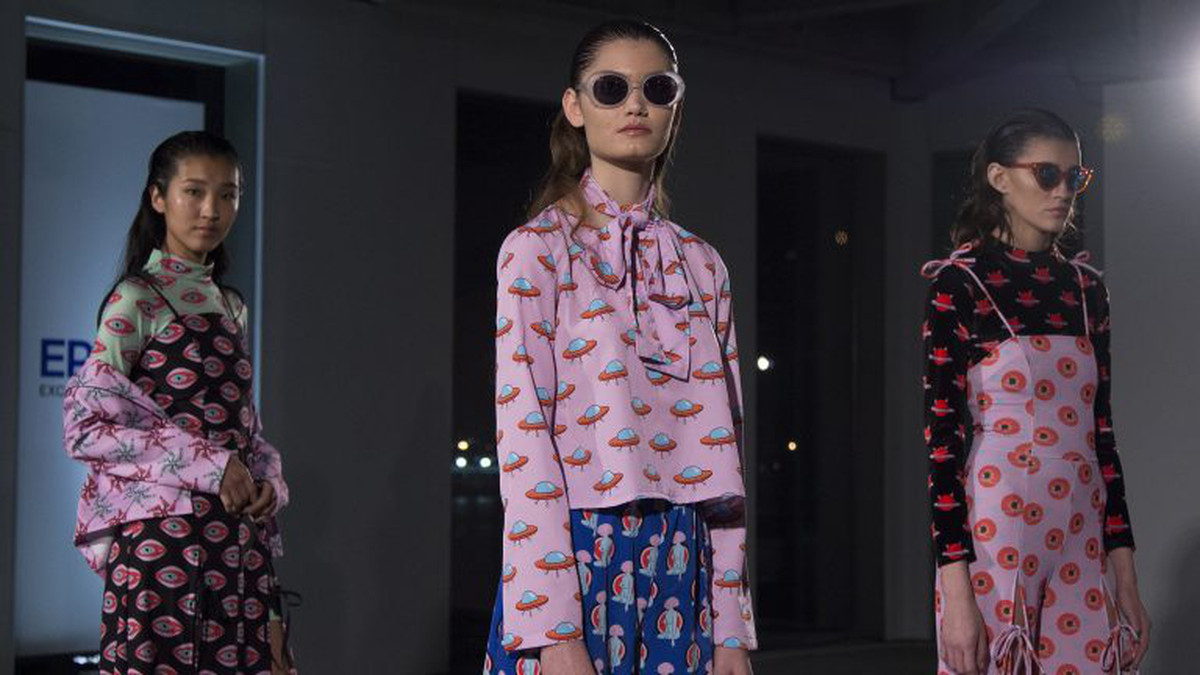Fashionphiles take note: Bright colors, bold patterns, and unique textiles are all the rage. The future of fashion was on full, vibrant display ahead of New York Fashion Week at the fourth annual Epson Digital Couture Project, February 6, 2018, at Pier 17.
Designers from North and Latin America exhibited thrilling new collections made with textiles created using Epson’s dye-sublimation printing technology. Utilizing Epson’s world-class textile printing solutions, the designers created breathtaking pieces that showcased their individual style around the theme “Cosmopolitan Couture with Impossible Colors – How Does Your Culture Dress-up?”
“I can think it, and I can make it in seconds,” said Los Angeles-based Honduran designer Fernando Alberto. “The only limitation is our mind.”
Alberto was one of 13 international design teams creating pieces for the event, including Michele Gevaerd, Hayley Elsaesser, Karyn Coo, Lina Cantillo, Stephanie Ruiz, Eduardo Figueroa, Emilio Mata, Ilse Jara, Ana Maria Guiulfo, Alexandra Pizzigoni, and Patricia Franklin from Thomas Jefferson University, Candice Cuoco and Gabriel Asfour, Angela Donhauser and Adi Gil of threeASFOUR. Stand-out collections included Alberto’s pieces, inspired by Russian art and religion, Mata’s stunning monarch butterfly print, and Cantillo’s menswear with galactic prints.
The speed with which designers are able to create their textile using Epson’s dye-sublimation printing, the variety of usable fabrics, and the ability to produce such vibrant colors yielded wildly unique collections and a group of designers eager to continue pushing the boundaries of the technology.
This was especially true for Elsaesser, who raved about the process of creating her collection, “Cosmic Dread,” a pop-art ode to space horror.
“Normally I get my stuff done overseas, so I love the idea that you can get it done so quickly and smoothly, and the colors are so vivid and amazing,” she said. “It’s cool to draw a print on the computer, and then you can have it instantly, actually, and it looks exactly like it does on the screen with the colors looking perfect.”
“Understanding how the industry has gone from these gigantic screens that have limited color ability, take four to six weeks to create and do one color at a time to digital printing, where we now have the spectrum of color with the exact specifications of what we want the print to be—and in a fraction of the time—it’s kind of remarkable,” said Aliza Licht, executive vice president of brand marketing and communications at Alice + Olivia.
Of course, the creative potential is just one benefit of the technology. Mark A. Sunderland, an accomplished textile engineer and largest endowed term chair at Thomas Jefferson University, also was quick to point out the effect digital textile printing has on the all-important bottom line.
“When it comes to cost-effectiveness, there really is no substitute for being able to print on fabric, see the designs, see how it drapes and be able to iterate that within an hour’s time,” he said.
This is especially true internationally, where Mexican fashion icon and analyst Anna Fusoni says the technology will have a big impact on struggling designers.
“To Mexican designers, we’re a very textile poor country,” she said. “Being able to create individual, differentiated designs that will make [designers] successful to their small following… I really think digital printing is changing their world.”
Elsaesser has been working with original prints for the majority of her career, but this project helped push American designer and Project Runway finalist Cuoco into using more prints in her work. Her high-drama collection inspired by women’s strength and healing incorporated gorgeous, painterly floral patterns alongside her signature edge.
“I’m known for solid black, and I’m known for my leather,” Cuoco said. “Now I’m like addicted because it helps bring your vision to life. As a brand, your customers trust you as if you were a person. If you don’t keep your story consistent and quality consistent, it’s like a relationship, they’re not going to trust you. Now I’m addicted, and I trust Epson.”
The exhibition was preceded by a panel of industry experts and visionaries discussing fashion’s future and technology, moderated by Anthony Cenname, vice president and publisher at WSJ. Magazine. The group discussed a range of topics, including sustainability, social media, and textile production.
